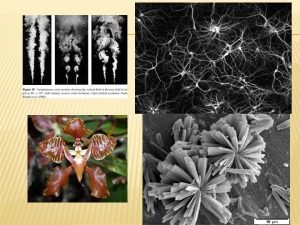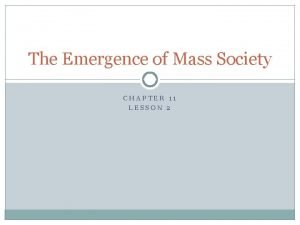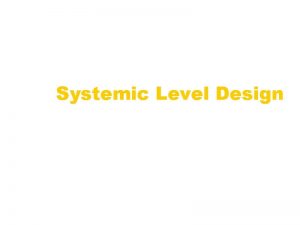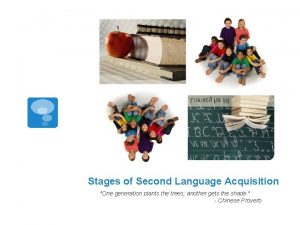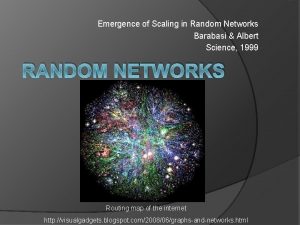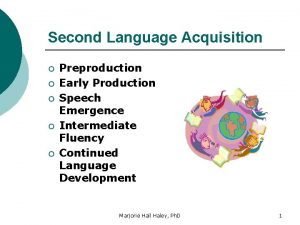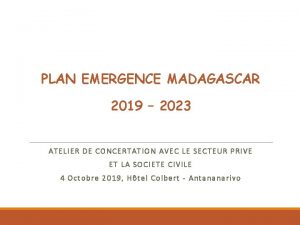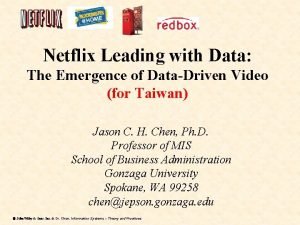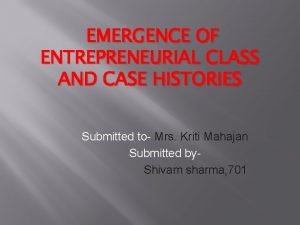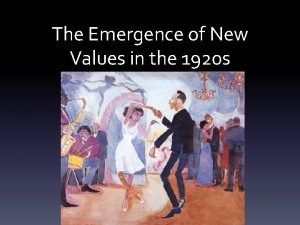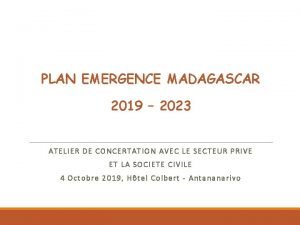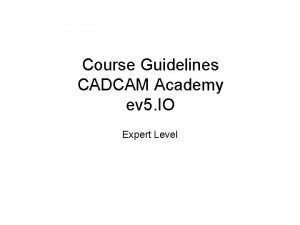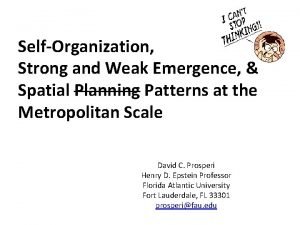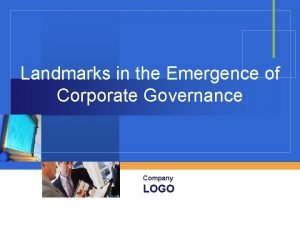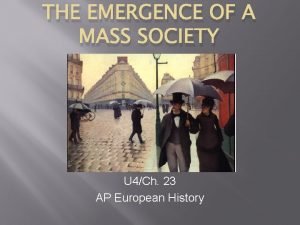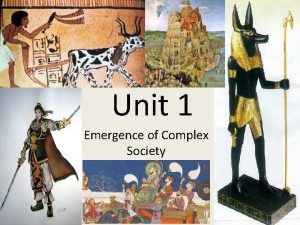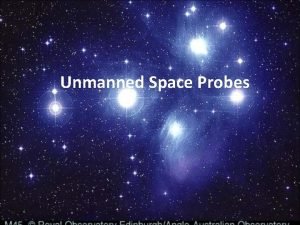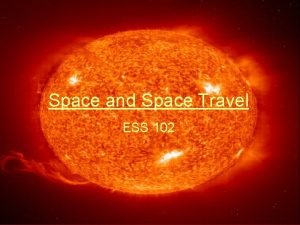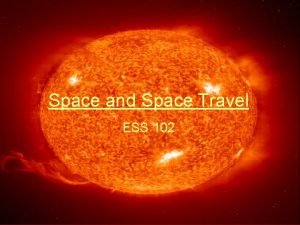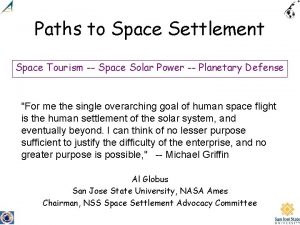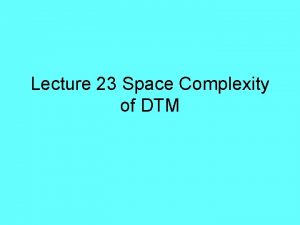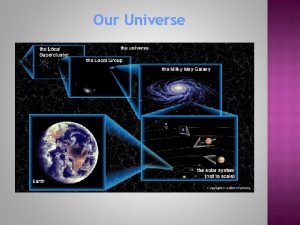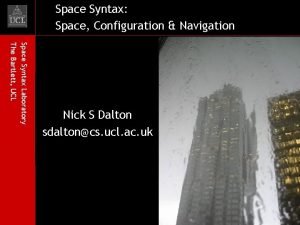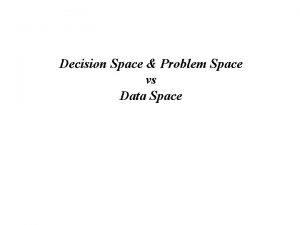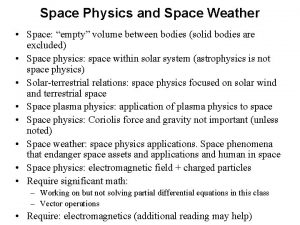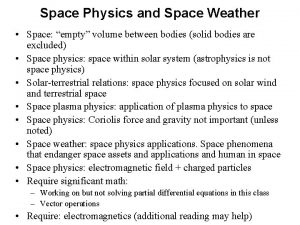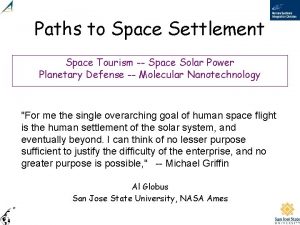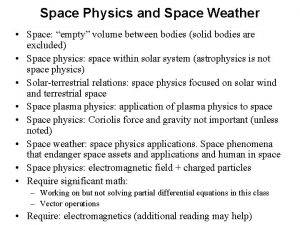The Emergence of Life Cycle Space Life Cycle



















































- Slides: 51


The Emergence of Life. Cycle. Space™ Life. Cycle. Ratio™ Life. Cycle. Balance™ Definitions Framework By Pliny Fisk. III David Armistead THE CENTER FOR MAXIMUM POTENTIAL BUILDING SYSTEMS AUSTIN, TEXAS


“A GEODESIC IS THE MOST ECONOMICAL RELATIONSHIP BETWEEN ANY TWO EVENTS” R BUCKMINSTER FULLER

“LIFE CYCLE BALANCING OF THE SOURCING AND RE-SOURCING OF ANY FLOW PROCESS SHOULD OPTIMALLY OCCUR AT THEIR COINCIDENCE WHEN SPATIALLY MAPPED” CMPBS - RESOURCE BALANCED LAND PLANNING METHODOLOGY FOR THE TEXAS PARKS AND WILDLIFE DEPARTMENT

Life Cycle Space™ contains the following attributes: 1) A GIS FRAMEWORK CONSISTING OF AN EQUAL AREA QUAD GRID MEASUREMENT SYSTEM OF MULTIPLE HIERARCHICAL BOUNDARIES FOR ABSOLUTE AND RELATIVE SPATIAL MEASURING 2) MEASUREMENT CONSISTING OF: A) GEOGRAPHIC RESOURCE AREAS ( MATERIAL /ENERGY/ FOOD ETC. AREAS THAT CONTAIN PRIME ATTRIBUTES ) B) POINTS (BUSINESSES, WITH LIFE CYCLE LINKAGE TO AREA RESOURCES) C) NETWORKS BETWEEN POINTS (LIFE CYCLE FLOWS CONNECTING SOURCING AND RE-SOURCING INCLUDING: ENERGY, MATERIAL, CURRENCY AND INFORMATION)

Life Cycle Ratio™ contains the following attributes: 1) 2) 3) 4) THE PROPORTION OF ANY COLLECTIVE OR PARTIAL LIFE CYCLE ACTIVITY OCCURRING WITHIN A GIVEN BOUNDARY AS OPPOSED TO OUTSIDE THAT BOUNDARY 2) 3) 4) 5) THE COMPARISON BETWEEN RATIO ACTIVITIES FROM ONE LOCATION TO ANOTHER OCCURS ONLY WHEN THE SAME EQUAL AREA GIS PROJECTION IS INCORPORATED

Life Cycle Balance™ contains the following attributes: 1) 2) 3) 4) 5) 6) 7) ONCE LIFE CYCLE TYPES (BUSINESS) AND ACTORS (LLIFE CYCLE PHASE) ARE GEOGRAPHICALLY IDENTIFIED (MATERIAL, -GASEOUS, LIQUID, SOLID; ENERGY -RENEWABL NON-RENEWABLE; MONETARY, OR INFORMATION), BALANCE IS DEFINED ACCORDING TO THE DEGREE OF SOURCING AS COMPARED TO RE-SOURCING OF THAT FLOW OCCURES WITHIN THAT DEFINED BOUNDARY 8) 9) 10) 11) 2) MEANINGFUL COMPARISON BETWEEN BALANCE IN ONE GEOGRAPHIC LOCATION TO ANOTHER IS ONLY POSSIBLE WHEN SIMILAR BIOGEOGRAPHIC CONDITIONS EXIST

AREA RESOURCE PLATT CURRE PROJECTION VEGETATIVE COVER CONTINENTAL U. S.

POINT AND NETWORK RESOURCES MAJOR HUMAN ACTIVITY AREAS CONTINENTAL U. S.

BASELINE-GREEN™ GREEN BALANCE™ TOOLS


+ CO 2 EMISSIONS BASELINE COMPARISON BUILDING 0 CO 2 EMISSIONS LIFE CYCLE BALANCING CO 2 emissions occur at every stage of a building’s life cycle. CO 2 balancing may be attained by using long-lasting CO 2 sink materials and products. BASELINEGREEN™ GREENBALANCE™

AS AN INPUT / OUTPUT MODELING TOOL BASELINE GREEN CAN OPERATE AT SEVERAL SCALES OF IMPACT FROM THE COUNTRY TO THE COUNTY AND EVEN ZIP CODE INPUT OUTPUT LIFE CYCLE ANALYSIS APPLIES TO COUNTRY, REGION, OR FACILITY BASELINE GREEN™

A Base Line Green™ has been created to better design and engineer environmentally and economically sophisticated buildings, towns and city regions using national data for the continental U. S. This data represent over 12 million U. S. businesses in a manner that not only shows their economic impact but their greenhouse gases, criteria air pollutants and toxic release. PURPOSE BASELINE GREEN™

Building accounts for roughly 40 percent of the materials flow in the global economy each year. In the U. S. , one-sixth to two-thirds of the environmental impact nationwide is due to wood and mineral extraction, water and energy, and the processing and manufacturing phases of the life cycle within the construction industry. This impact is associated directly to how all facets of the built environment are constructed, how they operate, and the manner in which maintenance occurs. BACKGROUND BASELINE GREEN™

1. Base lines the entire life cycle of 489 industrial categories within the U. S. economy and represents their environmental and economic impacts according to regions (includes 39 building construction sectors) 2. Correlates Standard Industrial Code (SIC) and its related Bureau of Economic Analysis code (BEA) to Construction Specifications Institute (CSI) and ASTM (Uniformat) categorization systems 3. Depicts impacts hierarchically and graphically for all major facets of buildings and utilities 4. Shows in GIS format where the generic condition effects environment and/or economies. TECHNIQUE BASELINE GREEN™

NAIC - Ready-mixed Concrete Plants BUILDING SPECIFICATION UNIFORMAT A 10 BASELINE GREEN™

NAIC - wood kitchen cabinets BUILDING SPECIFICATION UNIFORMAT C 10 BASELINE GREEN™

Area sources + re-sources Are subjected to suitability Analysis incorporating Ecological land planning methods. Point resources Are subjected to Regional input / output with embedded data sets + location Analysis according to SIC and GIS protocols. Network resources Are subjected to life cycle partitioning according to activity + probability network analysis for life cycle Clustering. Life Cycle Space™ - three primary attributes BASELINE GREEN™

EQUAL AREA PROJECTION AREAS LEVEL LONG DISTANCE (METRIC) LAT DISTANCE (METRIC) LONG DISTANCE (ENGLISH) LAT DISTANCE (ENGLISH) NORTH AMERICAN GRIDS I 720 KM 450 MILES 2 X 2 II 80 KM 50 MILES 10 X 10 III 16 KM 10 MILES 50 X 50 IV 3. 75 km 2. 4 miles 400 x 400 V 439 meters 669 feet 3, 600 x 3, 600 VI 83 meters 126 feet 18, 000 x 18, 000 VII 17 meters 53 feet 90, 000 x 90, 000 BASELINE GREEN™

EXAMPLE OF INFINITE GRID SCALES - WORLD TO COUNTY

Life. Cycle. Space™ & Life. Cycle. Ratio™

THE CENTER FOR MAXIMUM POTENTIAL BUILDING SYSTEMS PLATE CARRE EQUAL PROJECTION : 204 162 682 ACRES PER GRID CELL. CHINA’S FOOTPRINT NEEDS INTERNAL CAPACITY DEFICIT 8. 9 cells 12 cells SOURCE: REPORT Source: LIVING Sharing. PLANET nature’s interest

THE CENTER FOR MAXIMUM POTENTIAL BUILDING SYSTEMS PLATE CARRE EQUAL PROJECTION : 204 162 682 ACRES PER GRID CELL. EUROPE’S FOOTPRINT NEEDS INTERNAL CAPACITY 10. 5 cells DEFICIT 10. 5 cells SOURCE: REPORT Source: LIVING Sharing. PLANET nature’s interest

THE CENTER FOR MAXIMUM POTENTIAL BUILDING SYSTEMS PLATE CARRE EQUAL PROJ : 3 190 042 AC. GRID CELL. US LIFE CYCLE SPACE IMBALANCE U. S. FOOTPRINT NEEDS INTERNAL CAPACITY DEFICIT 17. 8 cells 13. 1 cells SOURCE: LIVING PLANET REPORT

THE CENTER FOR MAXIMUM POTENTIAL BUILDING SYSTEMS PLATE CARRE EQUAL PROJECTION : 3 190 042 ACRES PER GRID CELL. U. S. FOOTPRINT NEEDS USA CARBON IMBALANCE INTERNAL CAPACITY DEFICIT 17. 8 cells 48 cells SOURCE: LIVING PLANET REPORT

THE CENTER FOR MAXIMUM POTENTIAL BUILDING SYSTEMS PLATE CARRE EQUAL PROJ : 3 190 042 ACRES PER GRID CELL. AIR (CO 2) WATER -imbalanced ( 2. 7 times area of U. S. s. WWF, CENSUS, USDA) - Ground recharge, 0. 17 - Surface, 0. 18 (588% over balanced) USA INFORMATION HIERARCHY ENERGY -Non- renewable makes up 95% of the total energy supply MATERIALS -Recycled materials only make up 6% of total Spatial Numeric

THE CENTER FOR MAXIMUM POTENTIAL BUILDING SYSTEMS PLATE CARRE EQUAL PROJ : 3 190 042 ACRES PER GRID CELL. AIR (CO 2) - 8. 8 times area of Texas needed WATER - Ground recharge, 1. 67 - Surface, 0. 62 (160% imbalanced) TEXAS INFORMATION HIERARCHY ENERGY -only. 7% renewable (potential within state according to governors energy office could supply 25 times the present population of Texas MATERIALS - N/A Spatial Numeric

THE CENTER FOR MAXIMUM POTENTIAL BUILDING SYSTEMS PLATE CARRE EQUAL PROJECTION : 49 844 ACRES PER GRID CELL. AIR (CO 2) WATER FOOD - 62% tree cover loss* - 56% worse in water use ENERGY AUSTIN IMBALANCE - Renewable 4% of total MATERIALS - Solid waste recycled, 14% reduction* - 57% of local farming reduced* All Numeric * All over ten years

SIC READY-MIXED CONCRETE PLANTS BUILDING SPECIFICATION UNIFORMAT A 10 BASELINE GREEN™

QUAD TREE G. I. S NETWORK LIFE CYCLE. (UPSTREAM ANALYSIS) EXAMPLES CAN DEMONSTRATE LEVELS OF AREA RESOURCE OR POINT RESOURCE DEPENDENCY A LEVEL 1 LEVEL 2 LEVEL 3 LEVEL 4 1 B C E D 2 3 4 5 6 1 1 1 2 7 8 9 1 0 F 1 1 3 4 1 9 1 1 5 6 7 8 BASELINE GREEN™

National Ranking Life Cycle Space Infinite Information Hierarchy National upstream Environmental Impact Per $M of Construction Activity G. H. G Admissions Construction Sector Ranking Specification Ranking Component Ranking BASELINE GREEN™

National Ranking Industry Name 1. New bldgs & M and R 2. Retail trade, except eating & drinking 3. Petroleum refining Construction Sector Ranking Sector New nonfarm 1 unit resdt'l const. 4. Wholesale trade Nonresidt'l m & r construction 5. Eating and drinking places 6. Motor vehicles & passenger car bodies 7. Industrial inorganic & organic chemicals 8. Gas production and distribution (utilities) 9. Blast furnaces and steel mills 10. Miscellaneous plasics products Residential m & r construction New nonfarm additions & alterations const. Specification Ranking New hi-ways, bridges, etc. (xy-axis const. ) Category New office building construction Superstructure Highways & streets r & m construction Interior Finishes Foundations Component New academic facilities construction Exterior Closure New commercial structures Electrical Ready Mix Concrete New electric utility construction HVAC Hydrolic Cement Interior Const. Reinfocring Bar Plumbing Form Work Component Ranking Wire Life Cycle Space Infinite Information Hierarchy National upstream Environmental Impact Per $M of Construction Activity- G. H. G Admissions BASELINE GREEN™

National Ranking Construction Sector Ranking Specification Ranking Component Ranking Industry Name Sector 1. New bldgs & M and R New nonfarm 1 unit resdt'l const. Category 2. Retail trade, except eating & drinking Nonresidt'l m & r construction Superstructure Residential m & r construction Foundations Ready Mix Concrete 3. Petroleum refining New nonfarm additions & alterations const. Interior Finishes Reinfocring Bar 4. Wholesale trade New hi-ways, bridges, etc. Exterior Closure Form Work Electrical Wire New office building construction 5. Eating and drinking places Highways & streets r & m construction 6. Motor vehicles & passenger car bodies New academic facilities construction 7. Industrial inorganic & organic chemicals New electric utility construction 8. Gas production and distribution (utilities) New hospital construction 9. Blast furnaces and steel mills New warehouses construction 10. Miscellaneous plasics products Electric utilities r & m construction New commercial structures Component HVAC Interior Const. Plumbing New industrial plants construction New res. garden apts. construction New water supply facilities construction New telph & telgrph structures const. New sewer facilities construction New gas utility facilities construction Other new nonbuilding construction Life Cycle Space Infinite Information Hierarchy BASELINE National upstream Environmental Impact Per $M of Construction Activity- G. H. G Admissions GREEN™

Life. Cycle. Balance™

QUAD TREE NETWORK LIFE CYCLE BALANCING™ AREA OR POINT UPSTREAM SOURCE DOWN STREAM RE-SOURCE GREENBALANCE™

CDIR = (CO 2 e - CO 2 s) / weight of material Where CO 2 e = weight of upstream CO 2 emissions and CO 2 s = equivalent weight of CO 2 stored as carbon in the material Positive ratios indicate net carbon dioxide sources; negative ratios indicate net carbon dioxide sinks. CARBON DIOXIDE INTENSITY RATIO (CDIR) OF LONG-LASTING BUILDING MATERIALS GREEN BALANCE™

Life cycle CO 2 balance may be easier to attain at smaller scales. The carbon sink capacity of the biomass materials negates the upstream CO 2 emissions impact of all the materials used in the furnishing example illustrated above. A 50 -100 year product lifetime is assumed. INTERIOR FURNISHINGS LIFE CYCLE BALANCING GREEN BALANCE™

Life. Cycle. Space™ & Life. Cycle. Balance™

WATER HARVESTING WITH WASTEWATER SUITABILITY WATER HARVESTING SUITABILITY WASTE WATER TREATMENT SUITABLITY AREA SOURCE AND RESOURCE BALANCING SUITABILITY MAPPING GREENBALANCE™

AREA SOURCE AND RESOURCE BALANCING SUITABILITY MAPPING GREENBALANCE™


ZERI - ZERO EMMISSIONS RESEARCH INSTITUTE

UNISYN HAWAII - WASTE, FOOD, ENERGY, VITAMINS





OUTPUT The annual revenue value for products from UNISYN’s Hawaii facility: PRODUCT Electricity SCP Basil Algae PRICE $. 06/KW $300/Ton $1. 85/Pound $25. 00/Kilo ANNUAL REVENUE VALUE $33, 776 $1, 080, 000 $555, 000 $1, 534, 090 _____ TOTAL: $3, 500, 866 * 78% of the electricity is used to operate the plant.

 Emergence theory
Emergence theory The emergence of mass society
The emergence of mass society Systemic game design
Systemic game design Stages of second language development
Stages of second language development Emergence of scaling in random networks
Emergence of scaling in random networks Preproduction early production speech emergence
Preproduction early production speech emergence Plan emergence madagascar 2019-2023 pdf
Plan emergence madagascar 2019-2023 pdf Emergence netflix
Emergence netflix Entrepreneurship during post independence
Entrepreneurship during post independence The emergence of new values
The emergence of new values Plan emergence madagascar 2019-2023
Plan emergence madagascar 2019-2023 Itero göteborg
Itero göteborg Strong and weak emergence
Strong and weak emergence Landmarks in emergence of corporate governance
Landmarks in emergence of corporate governance Mass society
Mass society Joint space vs cartesian space
Joint space vs cartesian space Space junk the space age began
Space junk the space age began Camera space to world space
Camera space to world space Unscented trajectory chapter 5
Unscented trajectory chapter 5 World space computer
World space computer Hình ảnh bộ gõ cơ thể búng tay
Hình ảnh bộ gõ cơ thể búng tay Frameset trong html5
Frameset trong html5 Bổ thể
Bổ thể Tỉ lệ cơ thể trẻ em
Tỉ lệ cơ thể trẻ em Chó sói
Chó sói Tư thế worm breton là gì
Tư thế worm breton là gì Hát lên người ơi alleluia
Hát lên người ơi alleluia Môn thể thao bắt đầu bằng chữ đua
Môn thể thao bắt đầu bằng chữ đua Thế nào là hệ số cao nhất
Thế nào là hệ số cao nhất Các châu lục và đại dương trên thế giới
Các châu lục và đại dương trên thế giới Cong thức tính động năng
Cong thức tính động năng Trời xanh đây là của chúng ta thể thơ
Trời xanh đây là của chúng ta thể thơ Mật thư anh em như thể tay chân
Mật thư anh em như thể tay chân Phép trừ bù
Phép trừ bù Phản ứng thế ankan
Phản ứng thế ankan Các châu lục và đại dương trên thế giới
Các châu lục và đại dương trên thế giới Thơ thất ngôn tứ tuyệt đường luật
Thơ thất ngôn tứ tuyệt đường luật Quá trình desamine hóa có thể tạo ra
Quá trình desamine hóa có thể tạo ra Một số thể thơ truyền thống
Một số thể thơ truyền thống Cái miệng xinh xinh thế chỉ nói điều hay thôi
Cái miệng xinh xinh thế chỉ nói điều hay thôi Vẽ hình chiếu vuông góc của vật thể sau
Vẽ hình chiếu vuông góc của vật thể sau Thế nào là sự mỏi cơ
Thế nào là sự mỏi cơ đặc điểm cơ thể của người tối cổ
đặc điểm cơ thể của người tối cổ V. c c
V. c c Vẽ hình chiếu đứng bằng cạnh của vật thể
Vẽ hình chiếu đứng bằng cạnh của vật thể Phối cảnh
Phối cảnh Thẻ vin
Thẻ vin đại từ thay thế
đại từ thay thế điện thế nghỉ
điện thế nghỉ Tư thế ngồi viết
Tư thế ngồi viết Diễn thế sinh thái là
Diễn thế sinh thái là Các loại đột biến cấu trúc nhiễm sắc thể
Các loại đột biến cấu trúc nhiễm sắc thể
